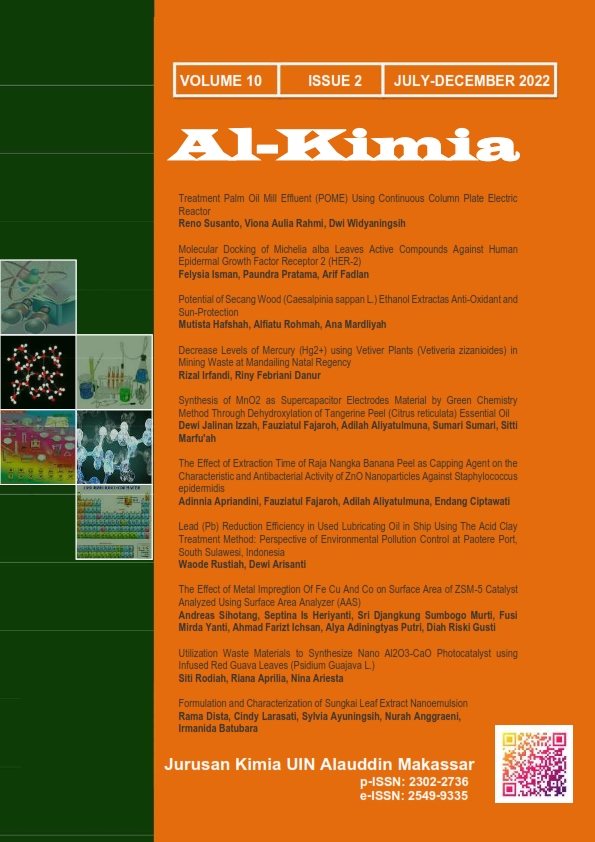The Effect of Metal Impregnation Of Fe Cu And Co on Surface Area of ZSM-5 Catalyst Analyzed Using Surface Area Analyzer (AAS)
Abstrak
ZSM-5 is a heterogeneous catalyst commonly used for petroleum cracking reactions and gas conversion processes ZSM-5 has a pore size of 0.54 nm × 0.56 nm with a surface area of 306.178 m2/g. To improve the performance of the ZSM-5 catalyst, it is necessary to impregnate it so that the surface area of the catalyst becomes smaller. One of the impregnation methods used is wet impregnation with the added metal of 2.5% wt, then characterized by using a Surface Area Analyzer (SAA). The results of the analysis showed that the surface area of the ZSM-5 catalyst impregnated with Fe, Cu, and Co, was 291,853m2/g, 302,390m2/g, and 291,504m2/g, respectively. The diameter of the pores of the ZSM-5 catalyst impregnated with Fe, Cu, and Co, respectively were 3.3896nm, 3.2688nm, and 3.2790nm, and the total volume of the pores of the ZSM-5 catalyst impregnated with Fe, Cu and Co metals, respectively, are 0.24732 cc/g, 0.24712cc/g, and 0.23896 cc/g, respectively. Therefore, the addition of Fe, Cu, and Co metals on the surface of the ZSM-5 catalyst will reduce the surface area of the catalyst, reduce the total pore volume and reduce the diameter of the pores of the ZSM-5 catalyst.
##plugins.generic.usageStats.downloads##
Referensi
Abdullah, M., & Khairurrijal, K. (2009). Review: Karakterisasi Nanomaterial. J. Nano Saintek, 2(1), 1–9.
Alothman, Z. A. (2012). A review: Fundamental aspects of silicate mesoporous materials. Materials, 5(12), 2874–2902. https://doi.org/10.3390/ma5122874
Aregawi, A. (2021). Relation between BET surface area and pore volume?
Beznis, N. V., Van Laak, A. N. C., Weckhuysen, B. M., & Bitter, J. H. (2011). Oxidation of methane to methanol and formaldehyde over Co-ZSM-5 molecular sieves: Tuning the reactivity and selectivity by alkaline and acid treatments of the zeolite ZSM-5 agglomerates. Microporous and Mesoporous Materials, 138(1–3), 176–183. https://doi.org/10.1016/j.micromeso.2010.09.009
Chen, L., Choong, C. K. S., Zhong, Z., Huang, L., Ang, T. P., Hong, L., & Lin, J. (2010). Carbon monoxide-free hydrogen production via low-temperature steam reforming of ethanol over iron-promoted Rh catalyst. Journal of Catalysis, 276(2), 197–200. https://doi.org/10.1016/j.jcat.2010.08.018
Cychosz, K. A., & Thommes, M. (2018). Progress in the Physisorption Characterization of Nanoporous Gas Storage Materials. Engineering, 4(4), 559–566. https://doi.org/10.1016/j.eng.2018.06.001
Dewajani, H., Rochmadi, Purwono, S., & Budiman, A. (2016). Effect of modification ZSM-5 catalyst in upgrading quality of organic liquid product derived from catalytic cracking of Indonesian nyamplung oil (Calophyllum inophyllum). AIP Conference Proceedings, 1755(2016), 1–7. https://doi.org/10.1063/1.4958485
Krisnandi, Y. K., Yusri, S., Gotama, H. S., Octaviani, S., & Sihombing, R. (2012). Synthesis and Characterization of Hierarchical Co/ZSM-5 as Catalyst for Methane Partial Oxidation. International Journal of Environment and Bioenergy, 3(2), 121–131.
Mansouri, S., Benlounes, O., Rabia, C., Thouvenot, R., Bettahar, M. M., & Hocine, S. (2013). Partial oxidation of methane over modified Keggin-type polyoxotungstates. Journal of Molecular Catalysis A: Chemical, 379, 255–262. https://doi.org/10.1016/j.molcata.2013.08.006
Morina, M., & Sidjabat, O. (2009). Pengaruh logam Kalsium (Ca) dan Kromium (Cr) dalam Pembuatan Bio-gasoline (Setara Bensin) dengan Bahan Baku Metil Ester. Lembaran Publikasi Minyak Dan Gas Bumi, 43(2), 88–97.
Narsimhan, K., Iyoki, K., Dinh, K., & Román-Leshkov, Y. (2016). Catalytic oxidation of methane into methanol over copper-exchanged zeolites with oxygen at low temperature. ACS Central Science, 2(6), 424–429. https://doi.org/10.1021/acscentsci.6b00139
Pednekar, P. P., Godiyal, S. C., Jadhav, K. R., & Kadam, V. J. (2017). Mesoporous silica nanoparticles: A promising multifunctional drug delivery system. In Nanostructures for Cancer Therapy. Elsevier Inc. https://doi.org/10.1016/B978-0-323-46144-3.00023-4
Permana, E., Cristine, I., Murti, S. D. S., & Yanti, F. M. (2020). PREPARASI DAN KARAKTERISASI KATALIS Cu / ZnO DENGAN SUPPORT KARBON AKTIF MENGGUNAKAN AKTIVATOR H3PO4 DAN ZnCl2. Jurnal Teknologi, 13(1), 6–15.
Sarifudin, K., Lado, D. Y., Utami, F. S., & Parera, L. A. M. (2020). Sintesis Dan Karakterisasi Sifat Keasaman , Morfologi , Luas Permukaan Spesifik , Rerata Jejari Pori Dan Volume Tatal Pori Katalis K-CoMo / ZAA. Prosiding Webinar Nasional Pendidikan Dan Sains Kimia 3 Tahun 2020, i, 72–81.
Sudarlin. (2012). Prinsip dan Teknik Penggunaan Gas Sorption Analyzer (GSA). Prinsip Dan Teknik Penggunaan Gas Sorption Analyzer (GSA), November 2012, 1–9. https://doi.org/10.13140/RG.2.2.13364.07048
Wang, L., Zhang, Z., Yin, C., Shan, Z., & Xiao, F. S. (2010). Hierarchical mesoporous zeolites with controllable mesoporosity templated from cationic polymers. Microporous and Mesoporous Materials, 131(1–3), 58–67. https://doi.org/10.1016/j.micromeso.2009.12.001
Widayat, W., & Annisa, A. N. (2017). Synthesis and Characterization of ZSM-5 Catalyst at Different Temperatures. IOP Conference Series: Materials Science and Engineering, 214(1). https://doi.org/10.1088/1757-899X/214/1/012032
Authors who publish with this journal agree to the following terms:
1) Authors retain copyright and grant the journal right of first publication with the work simultaneously licensed under a Creative Commons Attribution License that allows others to share the work with an acknowledgement of the work's authorship and initial publication in this journal.
2) Authors are able to enter into separate, additional contractual arrangements for the non-exclusive distribution of the journal's published version of the work (e.g., post it to an institutional repository or publish it in a book), with an acknowledgement of its initial publication in this journal.
3)Authors are permitted and encouraged to post their work online (e.g., in institutional repositories or on their website) prior to and during the submission process, as it can lead to productive exchanges, as well as earlier and greater citation of published work (See The Effect of Open Access).


